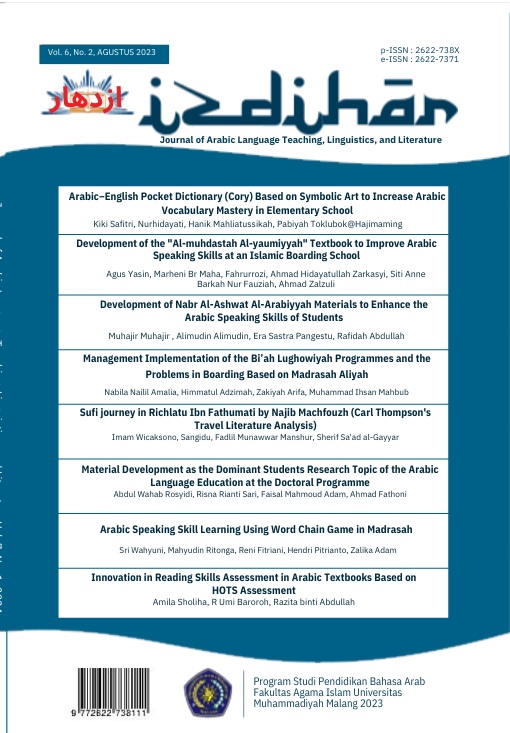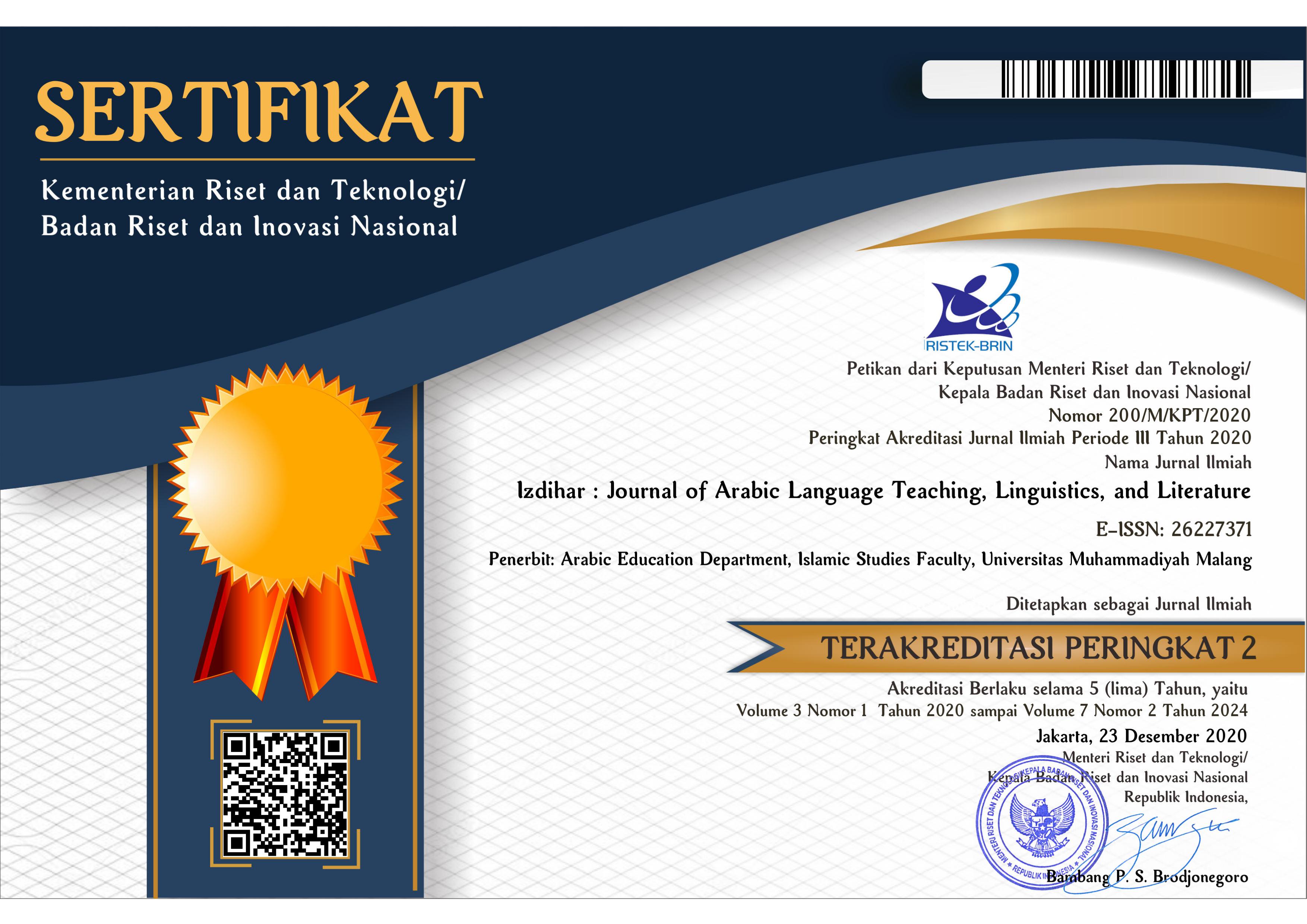Sufi journey in Richlatu Ibn Fathumati by Najib Machfouzh (Carl Thompson's Travel Literature Analysis)
DOI:
https://doi.org/10.22219/jiz.v6i2.18569Keywords:
Arabic literature, middle eastern studies, islamic literatureAbstract
This study aimed to understand the story of the journey of Sufi adherents while on a spiritual journey exploring several countries in the novel Richlatu-Ibnu Fathumati by Najib Machfouzh. This research used Carl Thompson's (2011) travel writing theory approach, which has three basic principles: reporting the world, revealing the self, and representing the other. The results of the study show that the Qandil journey is presented in three forms: (1) reporting the world in the form of stories about the conditions of the surrounding environment in the form of buildings, communities, and the natural surroundings; (2) revealing the self in the form of Qandil's feelings, emotions, and reactions during the trip. (3) representing the other: the reality of life at the place where Qandil stopped during the trip, which turned out to be a different culture from the cultural reality he had encountered in his home country. This research becomes important when the background of the traveller turns out to influence three narrative forms: reporting the world, revealing the self, and representing the other.
Downloads
References
Canon, M. (2020). Mystical Canon. McGinn 2012.
Forsdick. (2015). Travel and the body: Corporeality, speed and technology. In The Routledge Companion to Travel Writing (pp. 68–77). Taylor & Francis. https://doi.org/10.4324/9780203366127-16
Hassan, H. A. (2023). Sufi Feminism Women Leaders in African Sufi Movements. Journal of Religion in Africa, 46(4), 1–30. https://doi.org/10.1163/15700666-12340258
Heck, P. L. (2006). Mysticism as morality: The case of Sufism. Journal of Religious Ethics. https://doi.org/10.1111/j.1467-9795.2006.00268.x
Hooper, G. (2017). Perspectives on Travel Writing. Routledge Taylor & Francis Group.
Kuehn, S. (2023). Contemporary Art and Sufi Aesthetics in European Contexts. Religions, 14(2). https://doi.org/10.3390/rel14020196
Lala, I. (2023). Turning Religious Experience into Reality: The Spiritual Power of Himma. Religions, 14(3), 385. https://doi.org/10.3390/rel14030385
Machfuzh, N. (1983). Richlatu Ibnu Fathumati. Dar Misr.
Mahbub, F., Arif, R., Syadli, M., & Amril. (2022). The Existence And The Challenges Of Department of Philosophy and Religion . Faculty of Nusantara State Institute of Islamic Studies . Kabupaten Department of Aqidah and Islamic Philosophy . Faculty of Ushuluddin and Religion Studies . Imam Bonjol State. Afkar, 24(1), 243–270.
Manshur, F. M. (1998). Tasawuf dan Sastra Tasawuf dalam Kehidupan Pesantren. Jurnal Humaniora, 11(1), 102–109. https://journal.ugm.ac.id/jurnal-humaniora/article/view/631
Matthew B. Miles, & A. Michael Huberman. (1994). Qualitative Data Analysis (2nd ed., Vol. 2). Sage Publication.
Mirjalili, F. (2021). Goddess of the orient: Exploring the relationship between the persian goddess anahita and the sufi journey to mount qaf. Religions, 12(9). https://doi.org/10.3390/rel12090704
Mittermaier, A. (2012). Dreams from Elsewhere: Muslim subjectivities beyond the trope of self-cultivation. Journal of the Royal Anthropological Institute. https://doi.org/10.1111/j.1467-9655.2012.01742.x
Nath, P. (2023). Pilgrimage, performance, and peripatetic kingship: Akbar’s journeys to Ajmer and the formation of the Mughal Empire. Journal of the Royal Asiatic Society, 33(2), 271–296. https://doi.org/10.1017/s1356186322000153
Ni’am, S. (2020). The debate of orthodox sufism and philosophical sufism The Study of Maqamat in the Siraj al-Talibin of Shaykh Ihsan Jampes. Al-Jami’ah, 58(1), 1–34. https://doi.org/10.14421/ajis.2020.581.1-34
Purwanto, Y., Saepudin, A., Shofaussamawati, Islamy, M. R. F., & Baharuddin, D. (2023). Tasawwuf moderation in higher education: Empirical study of Al-Ghazālī’s Tasawwuf contribution to intellectual society. Cogent Social Sciences, 9(1). https://doi.org/10.1080/23311886.2023.2192556
Ridgeon, L. (2014). The Cambridge companion to sufism. In The Cambridge Companion to Sufism. https://doi.org/10.1017/CCO9781139087599
Sangidu. (2002). Konsep Martabat Tujuh Dalam At-Tuchfatul-Mursalah. Universitas Stuttgart, XIV(1), 1–11.
Sirriyeh, E. (2014). Sufis and anti-sufis: The defence, rethinking and rejection of sufism in the modern world. In Sufis and Anti-Sufis: The Defence, Rethinking and Rejection of Sufism in the Modern World. https://doi.org/10.4324/9781315027388
Smith, B. J., Hamdi, S., & Muzayyin, A. (2023). Female Sufi guides and the Murshida fatwa in Indonesian Sufism: Murshidas in a Sufi order in Lombok. Contemporary Islam, 0123456789. https://doi.org/10.1007/s11562-023-00522-z
Sorgenfrei, S., & Stjernholm, S. (2019). Salafi Sufism? Islamic border-keeping in contemporary Sweden. Approaching Religion, 77–91.
Thohri, M., & Hadisaputra, P. (2022). Urban Sufism of the Kopiah Community in Jayapura. Ulumuna, 26(1), 1–22.
Thompson, C. (2011). Travel Writing. In Routledge Taylor & Francis Group (1st ed.). Routledge Taylor & Francis Group.
Tousi, A. N. A. ibn A. Si. (1960). al-Luma’a.pdf (A.-Ch. Mahmud & T. A. al-B. Surur (eds.)). Dar al-Kutub al-Chaditsah.
Weismann, I. (2011). Modernity from within: Islamic fundamentalism and sufism. In Islam - Zeitschrift fur Geschichte und Kultur des Islamischen Orients. https://doi.org/10.1515/ISLAM.2011.018
Downloads
Published
How to Cite
Issue
Section
License
Copyright (c) 2023 Imam Wicaksono, Sangidu, Fadlil Munawwar Manshur, Sherif Sa'ad al-Gayyar

This work is licensed under a Creative Commons Attribution-ShareAlike 4.0 International License.
Copyright Notice
Authors who publish with this journal agree to the following terms:
- Authors retain copyright and grant the journal right of first publication with the work simultaneously licensed under a Creative Commons Attribution-ShareAlike 4.0 International License that allows others to share the work with an acknowledgment of the work's authorship and initial publication in this journal.
- Authors are able to enter into separate, additional contractual arrangements for the non-exclusive distribution of the journal's published version of the work (e.g., post it to an institutional repository or publish it in a book), with an acknowledgment of its initial publication in this journal.
- Authors are permitted and encouraged to post their work online (e.g., in institutional repositories or on their website) prior to and during the submission process, as it can lead to productive exchanges, as well as earlier and greater citation of published work (See The Effect of Open Access).
Copyright (c) 2019 Izdihar : Journal of Arabic Language Teaching, Linguistics, and Literature

This work is licensed under a Creative Commons Attribution-ShareAlike 4.0 International License.


















